 |
|
 |
| |
发行人:林恭如所长 编辑委员:吴肇欣教授 主编:林筱文 发行日期:2014.07.20 |
| |
|
|
 |
Si and SiC quantum dots co-doped Si-rich SiC p-i-n
junction diode with enhanced blue-green light emission
Professor Gong-Ru Lin's
Laboratory
Graduate Institute of Photonics and
Optoelectronics, National Taiwan University
台湾大学光电所 林恭如教授
Si quantum dots (Si-QDs) and SiC quantum dots (SiC-QDs) co-doped Si-rich silicon carbide (SixC1-x) based p-i-n junction light-emitting diodes (LEDs) with blue-green light emission is demonstrated. By growing the SixC1-x with plasma-enhanced chemical vapor deposition (PECVD) at relatively low temperature, the turn-on voltage of Si-rich SixC1-x LEDs can be reduced to 6.1 V when thinning i-SixC1-x layer to 25 nm because of higher tunneling probability and lower series resistance. The electroluminescent (EL) power increases to 136 nW, however, which inversely attenuates due to the reduced SiC-QDs if the i-SixC1-x thickness further shrinks to 25 nm. The principle EL peak at 500 nm with narrower shape and blue-green emission pattern is attributed to the self-trapped excitons at surface states among SiC-QDs. The external quantum efficiency (EQE) of the Si-rich SixC1-x LEDs with i-SixC1-x thickness of 50 nm is up to
1.58×10-1% with enhanced carrier tunneling probability. The carrier injection efficiency is enhanced to 46% by increasing the doping concentration to 1016
cm-3, leading to almost one order of magnitude improvement on the EQE of Si-rich SixC1-x LEDs.
|
 |
|
Figure Left: The TEM images (Upper) of the Si-rich SixC1-x films (Left) with co-doped SiC-QDs and Si-QDs in average sizes of 2.5 nm and 4.3 nm, respectively with the size distribution (Lower) of SiC-QDs and Si-QDs in the Si-rich SixC1-x film with the thickness of 50 nm. Middle: The I-V (Lower) and P-I (Upper) characteristics of the Si-rich SixC1-x p-i-n junction LEDs with different i-SiC thickness grown with the fluence ratio of 60%. Right: The EL spectra (Upper) of Si-rich SixC1-x p-i-n junction LEDs with the different i-SixC1-x thickness. Inset: the EL emission pattern. The carrier injection efficiency (Lower) of the Si-rich SixC1-x p-i-n junction LED as a function of n-type dopant concentration under fixed B2H6 doping concentration. |
Reference: Hung-Yu Tai, Chih-Hsien Cheng, and Gong-Ru Lin, “Blue-Green Light Emission from Si and SiC quantum dots co-doped Si-rich SiC p-i-n Junction Diode,”
IEEE J. Sel. Top. Quantum Electron., Vol. 20, Issue 4, 8200507, Jul.-Aug. 2014.
ITO-free
low-index transparent electrodes for enhancing
light out-coupling of organic light-emitting devices
Professor Chung-Chih Wu
Graduate Institute of Photonics and
Optoelectronics, National Taiwan University
台湾大学光电所 吴忠帜教授
The transparent conductor indium tin oxide (ITO) has been widely used in organic light-emitting devices (OLEDs) and other organic/inorganic optoelectronics as the transparent electrode. ITO, however, is rather expensive and thus not cost-effective due to scarcity of the indium element on earth. ITO is also brittle and usually requires high-temperature processing, limiting its compatibility with flexible plastic substrates and thus its use for flexible devices. Accordingly, in recent years, alternative (ITO-free) transparent conductors/electrodes for replacement of ITO are being intensively pursued. Through our studies, we have developed high-conductivity conducting polymers having excellent mechanical flexibility, good transmittance, solution processing capability, and low cost. Most importantly, they possess high conductivity of up to ~1000 S/cm, similar to that conventional ITO and sufficient to replace ITO as alternative transparent electrodes in various optoelectronic devices. Intriguingly, such high-conductivity conducting polymers also possess an optical refractive index significantly lower than those of ITO and typical organic layers in OLEDs and well matching those of typical OLED substrates. Optical simulation reveals that by replacing ITO with such a low-index transparent electrode, the guided modes trapped within the organic/ITO layers in conventional OLEDs can be substantially suppressed, leading to more light coupled into the substrate than the conventional ITO device (Fig. 1). By applying light out-coupling structures onto outer surfaces of substrates to effectively extract radiation into substrates, OLEDs using such low-index transparent electrodes achieve much enhanced optical out-coupling and electroluminescence efficiencies (EQE up to 45%, luminous efficiency up to185 lm/W) in comparison with conventional OLEDs using ITO (Fig. 2).
|
 |
|
Fig. 1. Calculated mode distributions (fraction of radiation coupled into different modes) of OLED internally generated radiation. |
|
 |
|
Fig. 2. External quantum efficiencies and luminous efficiencies of various devices. |
|
 |
| |
|
|
|
 |
|
| |
|
|
 |
论文题目:高强度全光纤奈秒掺镱光纤激光主从式放大器系统
姓名:张俊霖 指导教授:黄升龙教授
| 摘要 |
|
掺镱光纤激光与放大器 (ytterbium-doped fiber laser and amplifier) 可在一免校准光路且可靠又坚固的全光纤架构下,结合多模态且连续输出的半导体帮浦激光,高效率且稳定地产生热光效应与光束质量佳的高功率激光光束。本论文使用具高调制性的单模态半导体奈秒激光作为波长1064 nm的种子源,并建立一套全光纤主从式掺镱光纤激光放大器系统(master-oscillator power amplifier),在数奈秒的时宽下,其输出能量可达毫焦耳级,整体系统的能量增益与光转换效率为>63 dB 与>56%。藉由结合激光放大与非线性波长转换以避免显著的驱动能量耗尽,以及预放大器系统的最佳化设计,可成功地在线性偏振输出的功率放大器中产生峰值功率突破百千瓦的奈秒宽带连续频谱 (broadband continuum spectrum),其波长范围为980 nm到1600 nm且光转换效率达65%以上。另一方面,在应用端可产生稳定的激光光聚焦点,强度可达60 GW/cm2,用来形成热且浓稠的锡电浆源 (hot and dense tin plasma),且初步成功地侦侧到极紫外光 (extreme ultraviolet emission) 的讯号。
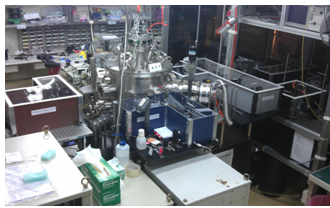 |
|
图一、高强度全光纤奈秒掺镱光纤激光主从式放大器系统与其应用端。 |
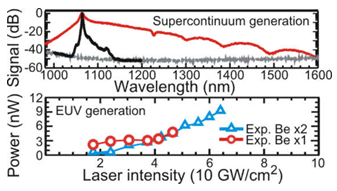 |
|
图二、高功率奈秒超宽带连续频谱(上)与锡电浆源激发极紫外光源的初步结果。 |
|
论文题目:氮化镓组件传播特性探讨
姓名:李季刚 指导教授:吴育任教授
| 摘要 |
|
本篇论文利用有限元素法(finite element method)解帕松(Poisson)和漂移-扩散(drift-diffusion)方程序来探讨氮化镓(GaN)组件传播特性,主要内容为分析氮化铟镓(InGaN)发光二极管(light-emitting diode)的电流扩布(current spreading)以及氮化镓奈米线(nanowire)场效晶体管的短通道效应(short-channel effect)。对传统水平式发光二极管来说,电流拥挤(current crowding)效应非常的严重,我们同时采用仿真结果和电路模型来分析电流扩布,结果显示,均匀的透明导电极没有办法真的让电流扩布非常的均匀。垂直型发光二极管会是一个有效改善电流扩布的结构,但传统上的电极设计还没有最佳化如图一。所以我们测试不同的电极配置,找出电流扩布的最佳化来抑制量子井(quantum well)里平均载子浓度和减少在高电流注入下时的效率衰退。而核壳型(core-shell)奈米线发光二极管比传统的平面发光二极管有更大的主动区,以及在非极性量子井里较强的复合,所以藉由增加奈米线的高度得到更大的深纵比,可以增加非极性主动区的体积以减少效率衰退效应(efficiency droop)。另外,图二为氮化镓奈米线的示意图。我们成功模拟50奈米闸极长度氮化镓奈米线晶体管的实验结果。而后,我们更进一步讨论20奈米的短通道效应。在有更好的环绕闸极(surrounding gate)设计和凹陷闸极(recessed gate)的方法,我们成功抑制20奈米闸极长度的短通道效应。
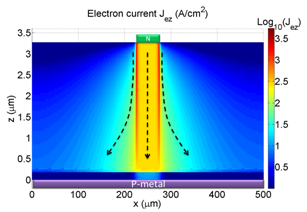 |
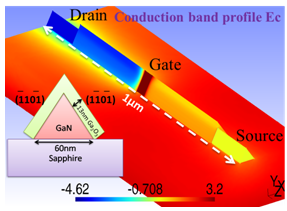 |
|
图一、传统垂直型发光二极管电子流分布图。 |
图二、奈米线晶体管电位分布以及结构示意图。 |
|
|
|
 |
|
 |
|
| |
|
|
 |
— 资料提供:影像显示科技知识平台 (DTKP, Display Technology
Knowledge Platform) —
—
整理:林晃岩教授、张劭宇 —
甲虫壳般的微透镜数组
微透镜数组有许多方面的应用,例如可以应用于芯片上光学实验室(optical lab-on-a-chip devices)、储存装置、光伏组件,目前制作这种微透镜数组的方法只能应用在平坦的基板上,而且因为制程有许多步骤,因此相当耗时。如今,法国CNRS的Chloé Bayon、Gonzague Agez和Michel Mitov等学者(Lab Chip 14, 2063–2071; 2014),开发了一种只需要一道制作程序就可以制作出胆固醇液晶微透镜数组之制程,并且可以将其制作于曲面或可挠曲的基板上;重要的是,此微透镜数组的聚焦与光束整形之功能可以随波长调变。
不像传统透镜是藉由透镜形状来产生聚焦功能,这种最新的微透镜是依靠胆固醇液晶本身的螺旋结构而产生光束整形的能力,它们是由一群多边形的胆固醇液晶所组成,每个多边形扮演着一维光子晶体(布拉格光栅)的角色,并且其周期是由胆固醇液晶之螺距所决定,这种微透镜数组就如同天然物种,例如:甲虫的壳一般。
此数组是在混入一些胆固醇液晶寡聚物后,经由退火以及快速冷却而成的;在退火的过程中,多边形的数组就会开始成形,如图1所示,退火之后再快速冷却形成最终的微透镜数组结构。
|
 |
|
图1、甲虫壳般的微透镜数组 |
研究人员藉由共轭焦显微镜与频谱仪来分析微透镜数组的光学特性,他们将此液晶结构分为三个操作频谱区域:布拉格区、边界区以及红光区,如图2所示,在布拉格区与边界区中,焦平面位于此微透镜数组之外,此时微透镜数组的功能犹如凸透镜一样;在红光区中,焦平面会与数组平面互相重迭,并且会产生甜甜圈形状般的光强度分布;布拉格以及边界区随着退火时间越长其频谱特性会蓝移,如图3所示。
|
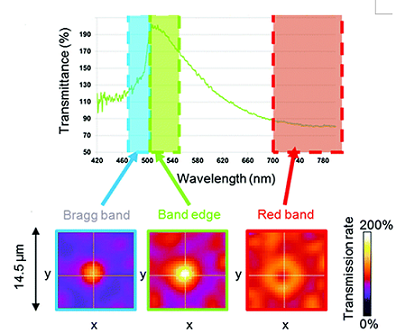 |
|
图2、三种操作频谱区间以及对应之穿透率示意图 |
|
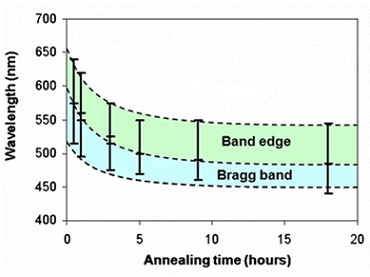 |
|
图3、布拉格以及边界区随着退火时间越长其频谱特性会产生蓝移现象 |
整个团队的领导人Michel Mitov在Nature Photonics中指出:这种透镜数组是一个可以整合在芯片上光学实验室的多功能微型组件;而且还提供了多种光处理功能、无缝式的整合和机械稳定性等好处。在未来,这个团队打算在液晶结构中再额外加入一些染料,以研发微型激光数组。
|
参考资料: |
1. Simon Pleasants, Micro-optics: Beetle-like microlens array,
Nature Photonics 8, 505, (2014). doi: 10.1038/nphoton.2014.148, Published online: 27 June 2014.
http://www.nature.com/nphoton/journal/v8/n7/full/nphoton.2014.148.html
2. Chloé Bayon, Gonzague Agez, and Michel Mitov,
Wavelength-tunable light shaping with cholesteric liquid crystal microlenses, Lab Chip,
14, 2063-2071, 2014. DOI: 10.1039/C4LC00152D, Published online: 2 May 2014.
http://pubs.rsc.org/en/content/articlehtml/2014/lc/c4lc00152d
|
|
|
|
|
|
|
|
|
|
|
 |
|
 |
|
|
|
 |
|
 |
|